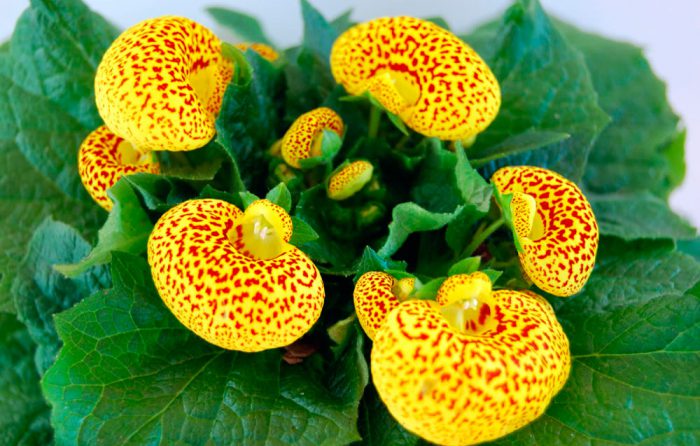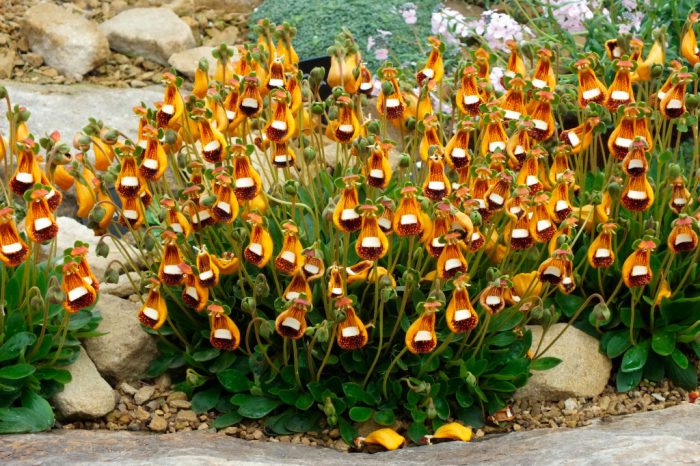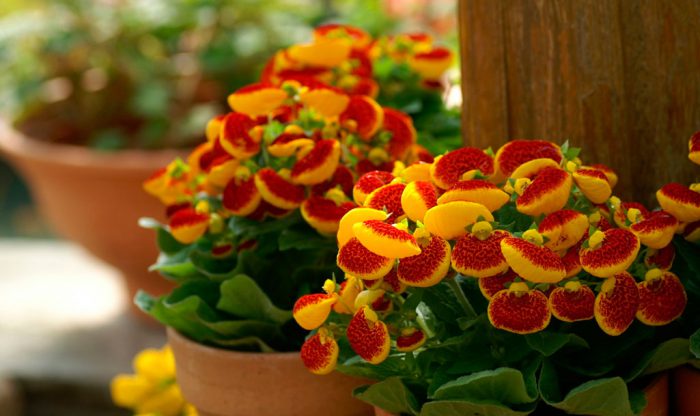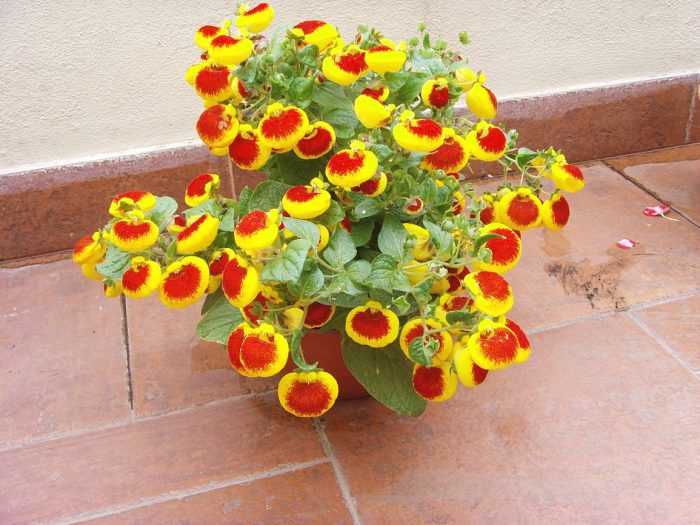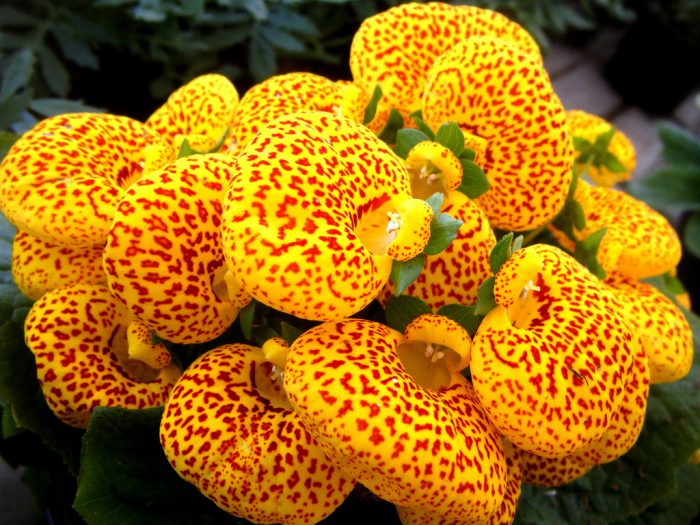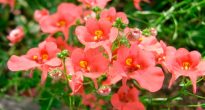A herbaceous and abundantly flowering plant like calceolaria at home it is grown as an annual or biennial. Its popularity is associated with very spectacular flowers that have an unusual shape, reminiscent of a "wallet" or "shoe". So, these bright flowers are double-lipped, the upper lip of which is extremely small, and the lower one is large, spherical, swollen.
The genus Calceolaria has about 400 species of the norichnik families. In English taxonomy, they are distinguished into the Calceolariaceae family. In the wild, this flower can be found in Central and South America. "Calceolaria" is translated from Latin as "small shoe".
This genus includes dwarf shrubs, grasses, shrubs, in which the leaves are located opposite or whorled. The flower calyx is four-membered, and the corolla is swollen, two-lipped (with the upper lip, as a rule, smaller). Has 2-3 stamens. The fruit is presented in the form of a box.
In calceolaria, most species are very beautiful and are grown as ornamental plants. Hybrid garden varieties were created from species such as: C. arachnoidea, C. corymbosa, C. crenatiflora, and others. For growing in cool greenhouses, as a rule, hybrids are chosen, the flowers of which are painted in purple, orange, yellow or red, and their corollas can also be shaded or with specks. For their reproduction, cuttings or seeds are used.
This beautifully flowering plant will delight you with its flowers in the spring, while you should know that growing it at home is problematic, as it prefers cool places. Its spherical, bright, bubbly flowers stand out. Flowers often have many different dots and spots. As a rule, calceolaria blooms from March to June. Flowering continues for 4 weeks. One plant can produce 18–55 flowers.
Content
Care features
Temperature regime
This flower needs coolness (12-16 degrees). If the air temperature is too high, flowers or buds may fall off.
Illumination
Likes well-lit places, but light should be diffused. Shading from direct sunlight is required. It is best to put on a windowsill located in the northern, eastern or northwestern part of the room.
How to water
Watering should be abundant. Do not overdry the earth.
Humidity
The flower needs very high humidity. It is recommended to pour small pebbles or expanded clay into a wide pallet, pour water, and put a flower pot on top. When spraying, try not to get the liquid on the pubescent leaves. Only flowers are sprayed.
How to transplant
The soil mixture consists of leaf, peat, turf soil, and sand, mixed in a ratio of 3: 2: 3: 1. When calceolaria has finished blooming, you can throw it away.
How to propagate
You can grow this plant from seeds. To do this, sowing is carried out from May to July, while dusting the seeds with earth is not done. Double pick required. For germination, the seeds need to provide a temperature of about 18 degrees. But it is difficult to grow this flower in indoor conditions; it is better to purchase a ready-made one in a special store.
How to properly care for calceolaria
Such a plant simply needs diffused light, and it does not tolerate the direct rays of the sun, from which it must be shaded. Grows well on window sills located on the west or east window. If the calceolaria is placed on a southern windowsill, then it needs good shading, which can be made from paper or a translucent material (for example, tulle, gauze, tracing paper, and so on). Also feels great on the northern windowsill. When the plant begins to bloom, it will not need very much shading. In the autumn-winter period, it is recommended to supplement the flower with fluorescent lamps.
For calceolaria to grow and develop normally, it needs the air temperature in the room to be no higher than 12–16 degrees, and, which is important, at any time of the year.
During the flowering period, watering should be regular. To do this, you need to use soft and always settled water. Moisten the soil immediately after the top layer dries. Some time after watering, be sure to pour out the liquid that has accumulated in the pan. When the flowering is over, you need to water the calceolaria very rarely and little, but make sure that the earthy lump does not dry out. After fresh growth appears, they gradually return to the previous irrigation regime.
This flower simply needs a very high air humidity, but at the same time, experts do not recommend moisturizing it from a spray bottle. In order to achieve the required humidity, the pot with the plant is placed on a pallet, into which water is poured and pebbles are placed, and you can also use moistened peat or expanded clay. It is also advised to place the flower pot in a pots, and fill the remaining space between the 2nd vessels with moist peat (it is moistened regularly).
The plant is fed for the first time, after 2 weeks have passed after transplanting the flower into a permanent pot. Mineral fertilizers are applied 2 times a month.
After this plant has faded, its aerial part can be completely removed. Then the pot should be moved to a dark, cool place for 6–8 weeks. Watering is rarely necessary, but the soil should not dry out completely. After the young growth appears, the pot is placed in a well-lit place, and after a while the calceolaria blooms. As a rule, such flowers begin to bloom a couple of months earlier than those grown from seeds. However, they are characterized by a loss of decorativeness, due to the fact that they are strongly stretched.
Over time, calceolaria will surely lose its decorative effect and quickly enough. To always have beautiful plants, you do not need to transplant them, but replace them with new ones.
How to propagate calceolaria
Seeds are used to propagate such flowers. If you want flowering to come in spring, then you need to sow them in June, and if in autumn, then in March.
The seeds of calceolaria are very small in size, so, in 1 gram, there are about 30 thousand pieces. Sowing is carried out directly on the soil surface, no additional dusting with earth is required.Paper is placed on top of the soil, and it must be systematically moistened. A pick is made after the seedlings have 2 true leaves. To create a suitable soil mixture, it is necessary to mix deciduous, humus and peat soil, as well as sand in a ratio of 2: 2: 2: 1.
Also, the seeds germinate well on peat. If you want flowering to come in mid-March, then sowing should be done from 5 to 15 July. To do this, use litter peat disinfected from rot by heating to 90-100 degrees. To reduce the acidity of peat, chalk is used. To do this, it is added to the substrate. 15-20 grams of ground chalk is taken per kilogram of peat. Also, peat is mixed with sand in a ratio of 7: 1. In the resulting mixture, the seeds are sown. To do this, they are scattered over the surface and not sprinkled on top with a substrate. Next, the container is tightly covered with glass or film. When condensation collects on the inner surface of the covering material, it must be carefully turned over so that water does not get onto the seedlings. Be sure to keep the substrate moisture constant.
The second pick into pots with a diameter of 7 centimeters is made after the appearance of the outlet. Then they are placed on light-colored windowsills. At the beginning of autumn, another transplant is carried out, and pots with a diameter of 9-11 centimeters are used for it. Do not forget to pinch the calceolaria before this transplant, only 2 or 3 pairs of leaves should remain, and lateral shoots will begin to grow from their sinuses.
You can also form a bush using pinching. To do this, you need to carefully remove the lateral shoots that are formed from the axils of the leaves.
Another transplant already into larger pots is performed from January to February. For this, a nutritious and heavy soil mixture is used, consisting of humus, turf and peat land, as well as sand, mixed in a ratio of 2: 2: 2: 1. Also, do not forget to add 2-3 grams of complex mineral fertilizer per kilogram of the mixture. This humus substrate must necessarily be slightly acidic (approx. PH 5.5).
Flowering occurs 8-10 months after sowing the seeds.
Growing difficulties
These flowers need to be replaced annually with new ones. It is not advisable to leave them for the next year.
The leaves wither and calceolaria ages quickly if the indoor air is too hot and dry.
Main types
Calceolaria mexicana (Calceolaria mexicana)
Such plants are difficult to combine with others. So, this type of calceolaria has very small flowers (diameter 5 millimeters) of a light yellow hue. They look most advantageous in the border along with flowers with decorative leaves, as well as in the composition located on the bank of the stream. Calceolaria corollas then look like little lanterns.
Under different conditions, the height of the bush may vary (from 20 to 50 centimeters). Taller bushes will be in a moist, shaded area with nutritious soil. In the wild, Mexican calceolaria can be found on the wooded slopes of the mountains of Mexico, because it is a heat-loving plant. But at the same time, the bright light of the sun does not tolerate well, only if it is provided with good watering. This flower almost always bears fruit abundantly and produces a large number of seeds.
Calceolaria rugosa - Calceolaria rugosa
This calceolaria is distinguished by its elegance and originality. Chile is her homeland.
Such a herbaceous perennial plant, which has a very branched erect stem (25-50 centimeters high), is most often grown as an annual. Small (1.5–2 centimeters in diameter) flowers have a bright yellow color. But there are forms that have brownish dots. Small leaves are collected in rosettes. If you sow this plant as usual, then it begins to bloom in June and continues - until the very frost. If there is a desire for this flower to bloom in the month of April, then it must be grown in containers.
Main varieties:
- Goldbukett - the plant has large flowers, and the height of a rather strong bush reaches 25-30 centimeters;
- Triomphe de Versailles - has small flowers, and the height of a fast-growing bush reaches 35-50 centimeters;
- Sunset (Calceolaria x hybridus) is a very spectacular plant that can be grown both at home and in the garden. On each rosette, consisting of dark green leathery leaves, about a dozen short peduncles appear. In this case, bell flowers can be colored orange, yellow or red. The bushes reach a height of 15–20 centimeters. They do not die with a short-term decrease in temperature to minus 5 degrees.

